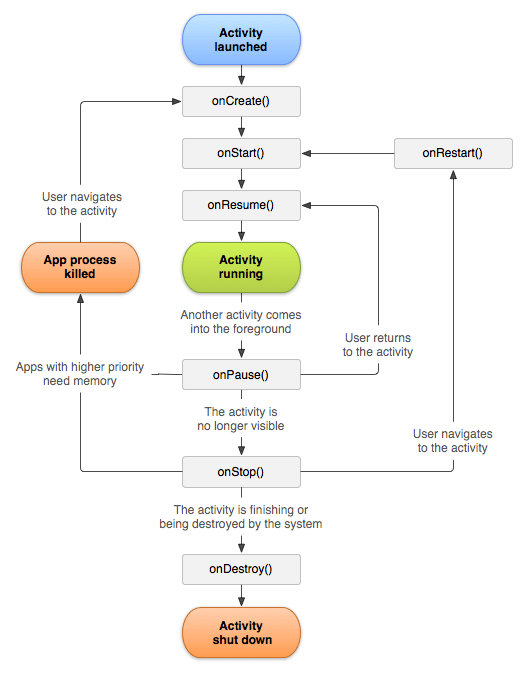Android Activity Lifecycle Explanation
The Android Activity lifecycle consists of various states that an Activity transitions through during its lifetime. These states allow the system to manage resources effectively and provide a seamless user experience. Here’s an overview of the lifecycle and its callback methods:
Lifecycle Callbacks
-
onCreate():
- Triggered when the Activity is first created.
- Used to initialize the Activity, set up the UI, and prepare resources like views or data binding.
- Called once during the Activity’s lifetime unless the system destroys it and recreates it (e.g., configuration changes).
Example:
override fun onCreate(savedInstanceState: Bundle?) { super.onCreate(savedInstanceState) setContentView(R.layout.activity_main) } -
onStart():
- Called when the Activity becomes visible to the user but is not yet interactive.
- The Activity enters the “Started” state.
- Often used for preparing UI elements or refreshing data.
-
onResume():
- Triggered when the Activity comes to the foreground and is fully interactive.
- The Activity is in the “Resumed” state, also referred to as the Running state.
- Handle real-time updates, user interactions, and animations here.
-
onPause():
- Called when the Activity is partially obscured but still visible (e.g., another Activity appears in front of it as a dialog).
- Release resources that don’t need to run when the Activity is not in the foreground, such as stopping animations or pausing media playback.
-
onStop():
- Triggered when the Activity is no longer visible (e.g., when navigating to another Activity or pressing the home button).
- Use this to release or save resources like database connections or network calls.
-
onRestart():
- Called after the Activity has been stopped and is about to restart.
- Typically followed by onStart().
- Useful for reinitializing components if necessary.
-
onDestroy():
- Called before the Activity is destroyed, either because the user finished it or the system is reclaiming memory.
- Clean up resources (e.g., unregister listeners, close database connections) to avoid memory leaks.
Lifecycle Flow
Normal Flow:
- onCreate() → onStart() → onResume()
- The Activity is created, becomes visible, and is ready for user interaction.
Interrupted Flow:
- The Activity is created, becomes visible, and is ready for user interaction.
- onPause() → onStop()
- The Activity is no longer in the foreground or visible (e.g., user navigates away or the system interrupts).
Restart Flow:
- onRestart() → onStart()
- When the Activity is returning to the foreground after being stopped.
End of Lifecycle:
- onDestroy()
- The Activity is destroyed and removed from memory.
Visual Representation

Key Notes
- onCreate() is called only once unless the Activity is destroyed.
- onPause() is the first callback triggered when the user leaves the Activity.
- Use onSaveInstanceState() to save UI state before the Activity is destroyed or stopped.
- onDestroy() is the final cleanup step; ensure resources are released here.
This structured approach ensures that the system manages resources efficiently and provides a responsive user experience.